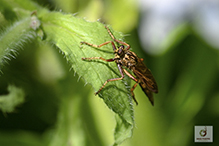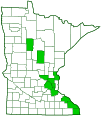robber fly
(Asilus sericeus)
Conservation • Description • Habitat • Biology • Distribution • Taxonomy
Conservation Status |
|
|||||||
| IUCN Red List | not listed |
|||||||
| NatureServe | not listed |
|||||||
| Minnesota | not listed |
|||||||
Description |
||
Asilus sericeus is a large, brown, early season, robber fly. It occurs in the United States from Maine to Georgia, west to Minnesota and Arkansas, and in southern Ontario Canada. Adults are found from mid-June through mid-July at woodland edges, in wet meadows, and in fields. They prey on moths and butterflies, but, unlike other members of the family, they are not known to prey on bees and wasps. Larvae live in the ground. Adults are ¾″ to 1⅛″ (20 to 28 mm) in length. The head is covered with golden-yellow hairs. There are two large compound eyes and three small simple eyes (ocelli). The compound eyes extend above the level of the top of the head (vertex), making the head appear hollowed out between the eyes when viewed from the front. They do not meet at the top of the head on either sex. The ocelli are arranged in a triangle on a prominent rounded projection (tubercle) in the middle of the head between the compound eyes. The face between the eyes is covered with hairs. There is a dense mustache of long stiff bristles (mystax) at the lower margin. The mystax has a thin layer of very long brownish-yellow hairs. There is also a cluster of forward-directed bristles (a “beard”) on the lower part of the face. The antennae are short and have 3 segments. The first segment is longer than the second. The third segment is longer than the first two combined. It is black and has a short bristle (arista) at the tip. The arista has two segments and is bare, not feather-like (plumose). The first segment is very short. The thorax is arched and stout. The upper side is covered with brownish-yellow hairs, and there is a broad, dark, sharply delineated, longitudinal stripe in the middle. The sides are reddish-brown and hairless. The abdomen is long, slender, half cylindrical, rounded on top, flat below, widest at the base, and tapering to the tip. It has seven segments. The first four segments are dark brown above and have a golden lower margin on the sides. The remaining segments are lighter. There are no bristles on the sides that are clearly longer than the hairs on the rest of the segment. On the female the abdomen tapers to a sharp point and is dark reddish-brown at the tip. On the male the tip is spoon shaped. The legs are stout and mostly brownish-yellow. The last part of the leg (tarsus), corresponding to the foot, has five segments. On the front and middle legs, often on the hind legs as well, the upper side of the third segment (femur), the tip of the fourth segment (tibia), and the last two segments of the tarsus are reddish-brown. The wings are light reddish-brown in the middle. The cells along the inner margin and at the wingtip are dark. The veins have pale margins. There are two submarginal cells. The first and second radius veins (R1 and R2+3) join before the end of R1 creating a closed cell that does not reach the margin. R5 reaches the wing margin beyond the wing tip. The veins that close the discal cell and the first posterior cell are not parallel. The anal cell is closed. |
||
Size |
||
Total length: ¾″ to 1⅛″(20 to 28 mm) |
||
Similar Species |
||
Habitat |
||
Woodland edges, wet meadows, and fields |
||
Biology |
||
Season |
||
Mid-June through mid-July |
||
Behavior |
||
|
||
Life Cycle |
||
|
||
Larva Food |
||
|
||
Adult Food |
||
Moths and butterflies |
||
Distribution |
||||
|
Sources |
|||
| 10/16/2022 | ||||
Occurrence |
||||
Not common |
||||
Taxonomy |
|||
Order |
Diptera (flies) | ||
Suborder |
Brachycera | ||
Infraorder |
Asilomorpha (Orthorrhapha) | ||
Superfamily |
Asiloidea | ||
Family |
Asilidae (robber flies) | ||
Subfamily |
Asilinae | ||
Tribe |
Asilini | ||
Genus |
Asilus | ||
Synonyms |
|||
Asilus herminius |
|||
Common Names |
|||
This species has no common name. The common name of the family Asilidae is robber flies, and it is used here for convenience. |
|||
Glossary
Arista
A large bristle on the upper side of the third segment of the antenna of a fly.
Femur
On insects and arachnids, the third, largest, most robust segment of the leg, coming immediately before the tibia. On humans, the thigh bone.
Mystax
On flies, especially in the family Asilidae, a patch of bristles or hairs (mustache) immediately above the mouth.
Tarsus
On insects, the last two to five subdivisions of the leg, attached to the tibia; the foot. On spiders, the last segment of the leg. Plural: tarsi.
Tibia
The fourth segment of an insect leg, after the femur and before the tarsus (foot). The fifth segment of a spider leg or palp.
Visitor Photos |
|||||
Share your photo of this insect. |
|||||
| This button not working for you? Simply email us at info@MinnesotaSeasons.com. Attach one or more photos and, if you like, a caption. |
|||||
Mike Poeppe |
|||||
 |
|||||
MinnesotaSeasons.com Photos |
|||||
|
|||||

Slideshows |
||

Visitor Videos |
|||
Share your video of this insect. |
|||
| This button not working for you? Simply email us at info@MinnesotaSeasons.com. Attach a video, a YouTube link, or a cloud storage link. |
|||
Other Videos |
|||

Visitor Sightings |
|||||
Report a sighting of this insect. |
|||||
| This button not working for you? Simply email us at info@MinnesotaSeasons.com. Be sure to include a location. |
|||||
| Mike Poeppe 7/28/2022 |
Location: Just west of Houston, MN |
 |
|||
MinnesotaSeasons.com Sightings |
|||||
|
|||||

Created: 10/16/2022
Last Updated:
